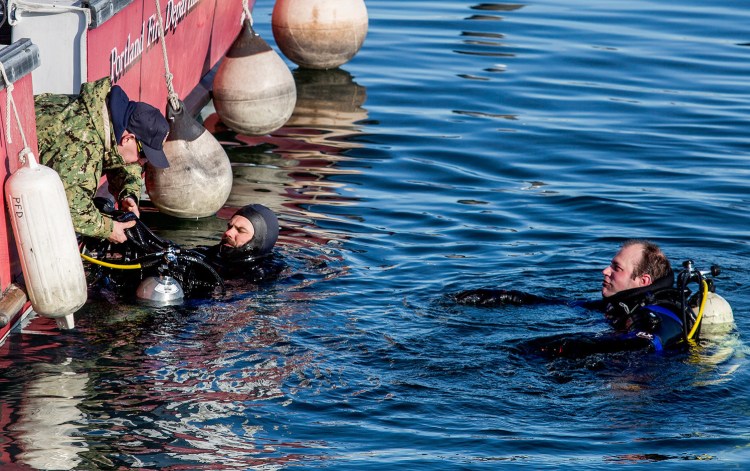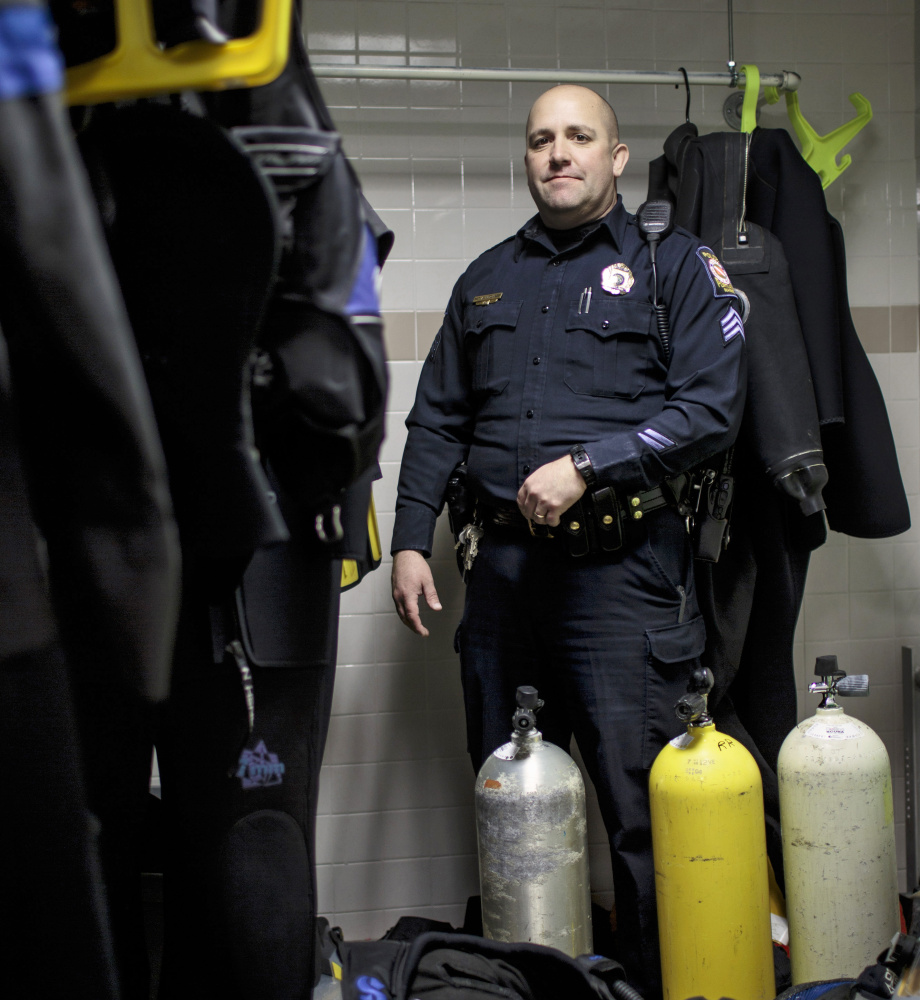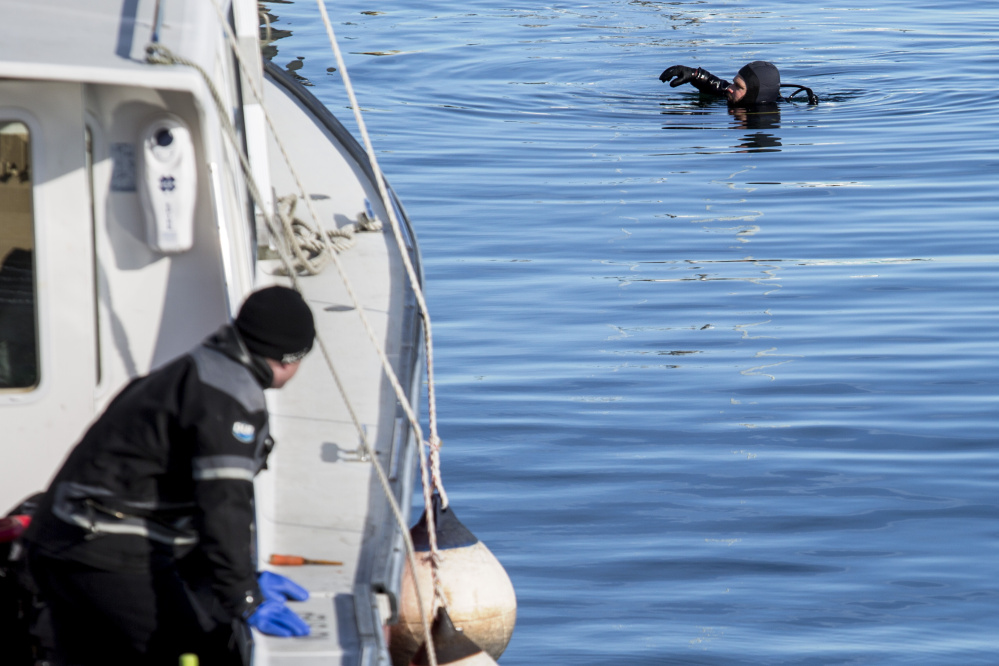Usually, when members of the Portland Police Department’s dive team are sent out on a search, there’s no question that they want to find what they’re looking for.
But when the search is for a missing person who may have fallen into the water, the goal of the mission is murkier.
“On the one hand, you found what you were looking for,” Sgt. Andy Hutchings, who supervises the dive team, said about the positive side of recovering a body.
The other side is that there’s no longer any hope – something the mother of 23-year-old James Dyer can hold onto after a three-day search in Portland Harbor this week came up empty.
“There’s certainly a sense of relief,” Amy Dyer said Wednesday after the dive team suspended its search for the Saco man, who was reported missing after spending New Year’s Eve in Portland.
Police decided to search the water around Union Wharf because the car he planned to get a ride home in was parked near there. As far as leads that can prompt a search, that’s hardly the least concrete.
“A lot of times it’s just a hunch,” Hutchings said.
For example, he said, it could be a tip that “someone said something about throwing something over Tukey’s Bridge.” And from there, they go.
Carrying as much as 80 pounds of equipment each, the team’s 10 divers, including three from South Portland police and a civilian consultant, take turns leaping two by two into the frigid water. One pair spends an hour in the water before two other divers take over. This week, the water was 40 degrees.
That was far from the most extreme conditions the divers have encountered. When there’s ice on the surface, they cut out a triangle and slide the sheet under the surface. Then they shovel paths in any snow on top of the ice, so they can follow the light shining through the paths to find the hole when it’s time to come up.
When the divers have to look beneath a pier, they wrap a cord around a piling and attach the other end to their wet or dry suit, so they can follow the cord back to the open water.
When they’re diving around a pier, the harbormaster positions his boat to cut off any mariners trying to enter the area, and the marine patrol broadcasts a message letting other boat operators know where the divers are. And if the divers are searching under a ship, they use chains and warning tags to prevent anyone from inadvertently turning the engine on and spinning the propeller.
Boat propellers clearly pose a danger, as the team was reminded in October when a Scarborough diver died from injuries suffered when the propeller of his fishing boat started to spin as he was trying to remove rope that was tangled around it. That fishing boat was tied up at the Portland Fish Pier, and it was the dive team that recovered his body.
Once the precautions are taken and the police divers enter the water, they let out air from a buoyancy control device on their suits and sink to the bottom, where they begin to methodically scour the search area, swimming across the sea floor.
Most of the time, if they’re lucky, they have a few feet of visibility. If not, they may only have their hands for searching.
A NEED FOR SKILLS AND EQUIPMENT
In this week’s search, because of the lack of storms churning up the water and causing runoff, the visibility was “uncommonly good,” Hutchings said. The divers could see 10 to 15 feet, giving them more confidence that the search was complete.
A few years ago, a federal Port Security Grant enabled the department to purchase two-way radios for the divers’ face masks, allowing them to talk to each other and their teammates above water. The grant also paid for a side-scan sonar apparatus that shows an image of the ocean floor to someone operating it from the deck of a boat.
Interpreting that image, however, is a skill of its own.
“What you’re looking for is something that looks like it doesn’t belong,” Hutchings said.
That means you have to know what does, including the shadows of a pier’s pilings and tires that, on the screen, look like Cheerios.
The sonar comes in most handy when the team is looking for a large object, like a car, or something, Hutchings said, “the size of a body.”
But more often than not what they’re looking for is much smaller, such as a handgun or a safe – evidence from a crime.
And while searching for one thing, they always end up discovering a lot more.
“Shopping carts, bicycles, fishing poles,” Hutchings said, to name a few. Once, while looking for a body, he found a stolen car upside-down in the harbor.
Sometimes, when they’re training, the divers pick up kelp or sea cucumbers to give to the Children’s Museum.
“And, no, I’ve never seen any sharks,” Hutchings said.
He also has never found a body, although he’s been with the team when it has.
In those cases, the divers are debriefed to make sure they didn’t experience any trauma.
“You’re looking for a person, it’s hard, but somebody’s got to do it,” Hutchings said.
It’s also a regular part of police work, he said, and officers are bound to come across a lot more bodies while patrolling the streets – what the dive team members do when they’re not in the water.
Hutchings said there can be a sense of accomplishment in recovering a body, especially if there are family members looking for closure. But it’s not a job he enjoys.
“If I didn’t ever have to go look for a body again, that would be perfect,” he said.
SYSTEMATIC AND PATIENT SEARCHES
Unless new evidence arises that Dyer may be somewhere else in the harbor, the team won’t have return to look for him.
By Thursday, Hutchings, the department’s community policing sergeant, was giving a talk about active shooter incidents. He’s also a firearms instructor on the force. It’s common for members of one special team to be on others, even though being on one is required. Most of the Portland officers on the dive team tried out for one of the six slots because they’re already recreational divers.
Police Cmdr. Gary Rogers said it takes a certain type of officer to serve on the team. “When you are searching for something as small as the size of your hand, you do have to be very systematic and patient and cautious and kind of stick to the plan,” he said.
“You can’t afford to be careless, because it’s dangerous.”
Rogers said the search was called off Wednesday because the team had sufficiently scoured the area.
Although most missions are complete once an item is located, the team can also accomplish its goal by determining something isn’t there.
The overall objective of both types of searching is the same.
“You just want to make sure you finish it,” Hutchings said.
Send questions/comments to the editors.






Success. Please wait for the page to reload. If the page does not reload within 5 seconds, please refresh the page.
Enter your email and password to access comments.
Hi, to comment on stories you must . This profile is in addition to your subscription and website login.
Already have a commenting profile? .
Invalid username/password.
Please check your email to confirm and complete your registration.
Only subscribers are eligible to post comments. Please subscribe or login first for digital access. Here’s why.
Use the form below to reset your password. When you've submitted your account email, we will send an email with a reset code.